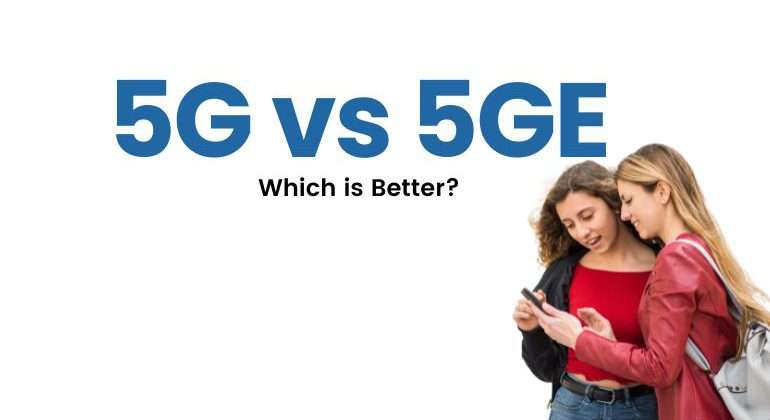In the world of mobile technology, the battle for faster, more reliable connections has led to a race towards 5G networks. As consumers eagerly await the rollout of true 5G, some wireless carriers have resorted to tactics that blur the lines between reality and marketing hype. AT&T’s introduction of 5GE is a prime example of this. We thought to do a quick comparison of 5GE vs. 5G and see how it differentiates from 5G.
In this blog post, we will discuss What 5GE is and how it differentiates from 5G; along with this, the blog will also cover the following headings:
- Difference between 5G and 5GE
- Which one should you pick?
- Public response to 5GE by AT&T
- Is 5GE still advertised today?
Table of Contents
What is 5GE?
5GE stands for 5G Evolution, a term created by AT&T. It was introduced to make consumers believe they were experiencing the cutting edge of 5G technology. However, the reality is quite different.
5GE is not 5G technology in speed; instead, it is an advanced version of 4G LTE, which offers incremental improvements in terms of speed and capacity.
AT&T’s decision to use the 5GE label for an advanced version of 4G LTE has been widely criticised. By using the “5G” label, AT&T creates a false impression that their network is on par with accurate 5G technology, potentially misleading consumers who expect the promised benefits of 5G.
AT&T’s 5GE label has confused the wireless industry, blurring the lines between 4G and 5G technologies. This confusion can hinder the adoption of a genuine 5G network.
This marketing strategy could give the company an unfair advantage in the market by making its network appear superior to competitors still building actual 5G infrastructure.
How Fast is 5GE?
To better understand how fast 5GE is, we must break down 5GE speed into several components: download and upload speed, latency, and network capacity, for example.
5GE offers a moderate improvement over standard 4G LTE, with typical download speeds averaging around 50-200 Mbps. This is significantly slower than the impressive speeds associated with actual 5G networks.
5GE doesn’t offer the same level of upload speed improvement as true 5G. It typically provides upload speeds like those of 4G LTE, ranging from 10-50 Mbps.
5GE, like 4G LTE, doesn’t deliver the same ultra-low latency as 5G. It typically has a latency ranging from 20-30 ms.
While 5GE offers improved network capacity compared to 4G LTE, it doesn’t reach the same level as 5G networks, potentially limiting its scalability for IoT and high-density applications.
Is AT&T 5GE Faster than 4G?
AT&T’s 5GE offers speed improvements over traditional 4G networks. However, it’s important to note that it’s not true 5G. When comparing download and upload speeds, 5GE generally performs better than 4G, but it’s not a revolutionary leap in speed.
Genuine 5G networks offer higher speeds, lower latency, and increased network capacity than 4G and 5GE.
So, to answer, Is AT&T’s 5GE faster than 4G? It is, yes, but only marginally. It’s an incremental improvement rather than a transformative shift in network speed. If you’re seeking the full benefits of 5G, you’ll have to look beyond 5GE and wait for the rollout of genuine 5G networks.
Difference Between 5G and 5GE
The evolution of wireless technology has brought us to the era of 5G, promising faster speeds, low latency, and improved network capabilities. However, the term “5GE” has also entered the scene, causing confusion among consumers.
This section explores the difference between the two concerning speed, wavelength, and network coverage so you can better understand the difference between them.
Speed
5G takes the lead when it comes to the internet speed. This internet generation is designed to provide faster download and upload speeds.
The speed you experience will depend on various factors, including your location, network infrastructure, and the frequency bands your carrier uses.
In contrast, 5GE is not true 5G. It’s more like an advanced version of 4G LTE, which falls short of the impressive speeds of genuine 5G. 5GE typically provides download speeds in the range of 50 to 200 Mbps, which, while faster than 4G, is still significantly slower than the capabilities of 5G.
Wavelength
Wavelength is another significant point of difference between 5G and 5GE. 5G operates in a broader range of frequency bands, including both high-band (mm-wave) and mid-band spectrum, which allows for the delivery of high-speed, low-latency services.
In contrast, 5GE primarily operates on the same frequency bands as 4G LTE, making it less versatile regarding wavelength. While it can offer improvements in speed and capacity over 4G, it lacks the broad-spectrum coverage that 5G can provide, especially in urban areas.
Compatibility with Devices
Compatibility is a crucial factor for consumers. 5G networks are designed to support a wide range of devices, from smartphones and tablets to IoT devices and even autonomous vehicles. It’s built to accommodate the diverse needs of the modern digital landscape.
5GE, however, may not be as compatible with a broad range of devices as 5G. Since it’s essentially an enhancement of 4G LTE, which isn’t optimised for the same level of device density and diversity that 5G can handle. This makes 5GE potentially less suitable for IoT and other applications that require seamless connectivity for numerous devices.
Coverage
The coverage aspect also sets 5G and 5GE apart. 5G networks are being rolled out globally, increasing coverage in cities and urban areas. They offer the potential for extensive coverage in the future, significantly when leveraging low-band frequencies.
5GE, however, is primarily limited to areas where AT&T has deployed this enhanced version of 4G LTE. Its coverage is more localised and less spread than 5G networks, which are expanding rapidly.
Which One Should You Pick?
The choice between 5G and 5GE has become a hot topic in wireless technology. As consumers, we all want faster speeds, lower latency, and seamless connectivity, but understanding the differences between these two options is crucial to making the right decision.
When it comes to speed, true 5G takes the lead. It’s designed to provide remarkable download and upload speeds, potentially reaching multiple gigabits per second. Talk Home’s 5G data with high-speed capability is ideal for data-intensive tasks like streaming, online gaming, and downloading large files in the blink of an eye.
The wavelength spectrum also differs between 5G and 5GE. 5G operates on a broader range of frequency bands, including high-band (mm-wave) and mid-band spectrum. This spectrum versatility allows for high-speed, low-latency services and makes 5G suitable for various applications.
5G is designed to support a wide range of devices, from smartphones and tablets to Internet of Things (IoT) devices, smart city infrastructure, and even autonomous vehicles. It’s versatile and can meet the diverse needs of modern technology.
Also, the 5G networks are expanding globally, increasing coverage in urban areas. They offer the potential for extensive coverage in the future, especially when utilising low-band frequencies. However, 5G coverage may not be as comprehensive in remote or rural areas.
Public Response to 5GE by AT&T

AT&T’s launch of 5GE received a mixed and often critical response from the public and the tech industry. The public response to 5GE revolves around confusion, criticism, and mistrust. National Advertising Review Board also asked AT&T to stop misleading about 5GE.
The most prominent reaction to 5GE was widespread confusion. Many consumers believed that 5GE was synonymous with 5G, which led to high expectations of revolutionary speed and performance. However, tech-savvy individuals and industry experts quickly clarified that 5GE is essentially an advanced version of 4G LTE.
The rollout of 5GE was criticised by competitors, consumer advocacy groups, and even some regulators. Many accused AT&T of misleading advertising, as the label “5GE” implied a level of technological advancement that wasn’t truly representative of the network’s capabilities.
The controversy surrounding 5GE led to mistrust in AT&T’s marketing practices. Consumers have become more vigilant about discerning genuine 5G networks from marketing ploys, which affects how carriers present their network advancements.
While the confusion around 5GE didn’t hinder the adoption of actual 5G networks, it added some noise to the conversation, making it crucial for consumers to be well-informed and understand the differences between 5G and 5GE.
Bottom Line
The battle between 5GE and 5G has left many consumers puzzled. While both terms might sound similar, they represent two vastly different technologies. 5GE, often marketed by some carriers as an upgrade from 4G, stands for 5G Evolution.
However, it’s essential to realise that 5GE is not a true 5G. Instead, it’s more of a marketing ploy, as it doesn’t offer the revolutionary improvements in speed and latency that 5G promises. When assessing the choice between 5GE and 5G, it’s crucial to look beyond the name and focus on the real-world benefits of 5G technology.
On the other hand, 5G is the real game-changer. With blazing-fast download and upload speeds, significantly reduced latency, and the potential to enable transformative technologies like the Internet of Things (IoT), autonomous vehicles, and augmented reality, 5G is set to revolutionise how we connect and interact with the digital world.
It’s not just about faster downloads; it’s about unlocking the potential for a connected world where devices communicate seamlessly, paving the way for a future we can only imagine. So, make the right choice and invest in 5G for a genuinely next-level wireless experience.

